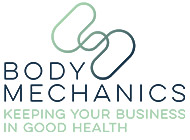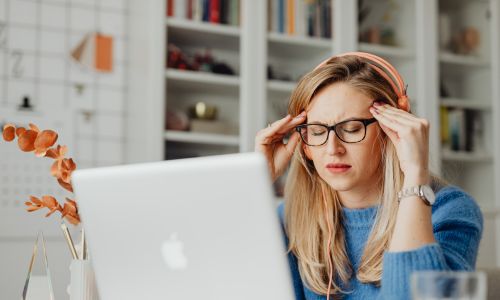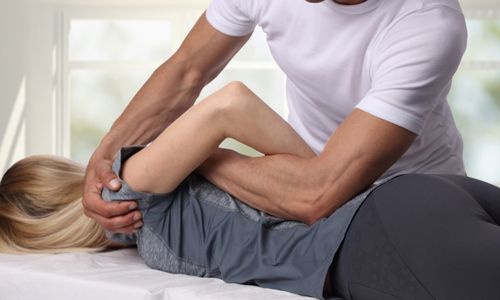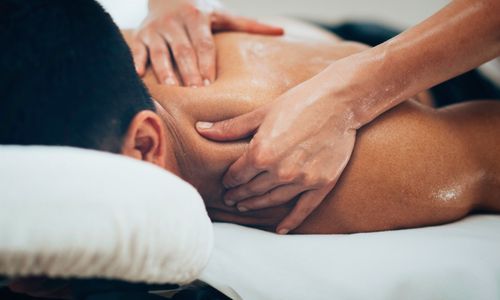Physical Conditions in UK Workplaces
Stress, depression and anxiety affect us all at some point, so what does that mean for UK workplaces?
Stress, depression and anxiety affect us all at some point, so what does that mean for UK workplaces?
In this article we explore the benefits of stretching to your physical and mental wellbeing.
In this article, I share a podcast recommendation which was made to me by one of my private clients.
Thumper Massagers are ‘at home’ massage tools, which have been created with convenience and accessibility in mind. They are handheld devices which use percussive action to work into muscles and are designed to help loosen any muscle tension and tightness being experienced. You can use Thumper Massagers to provide massage treatment on yourself or on another person. They’re great as a quick fix or a top up treatment, in between your usual physical therapy schedule.
We have selected two Thumpers from our healthcare product provider, Physique which we think will be best suited to our clients, based on your questions and your treatment requirements. Should you wish to buy either of these Thumpers, the links are below and a 10% discount is available to Body Mechanics’ clients.
We hope this review will help you make an informed decision about how and which Thumper Massagers may be of benefit to you.
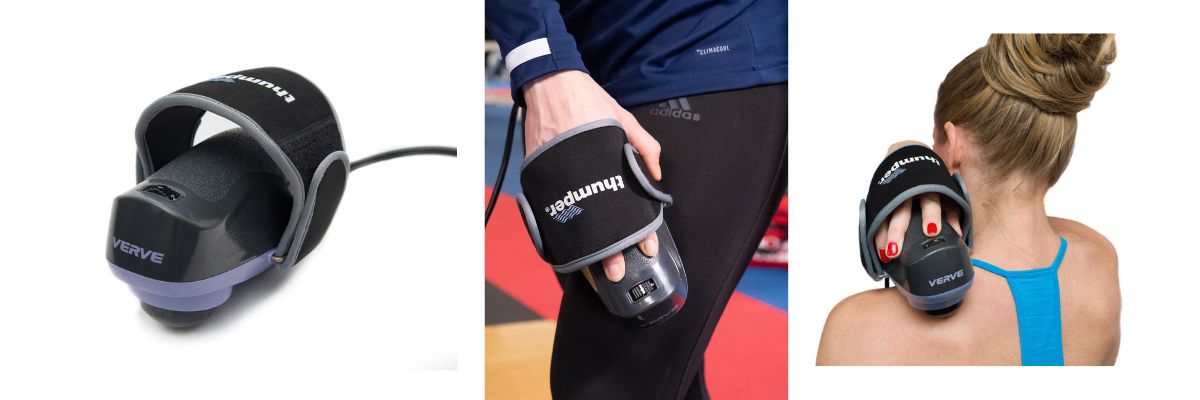
Working into targeted or smaller areas
⭐️⭐️⭐️⭐️ (4 stars)
We’d buy this! We found it a quick and effective fix to help ease any tightness in specific areas e.g. lower neck/shoulder line, lower back close to the spine, glute/hip, fronts of shins, feet and ankles, forearms.
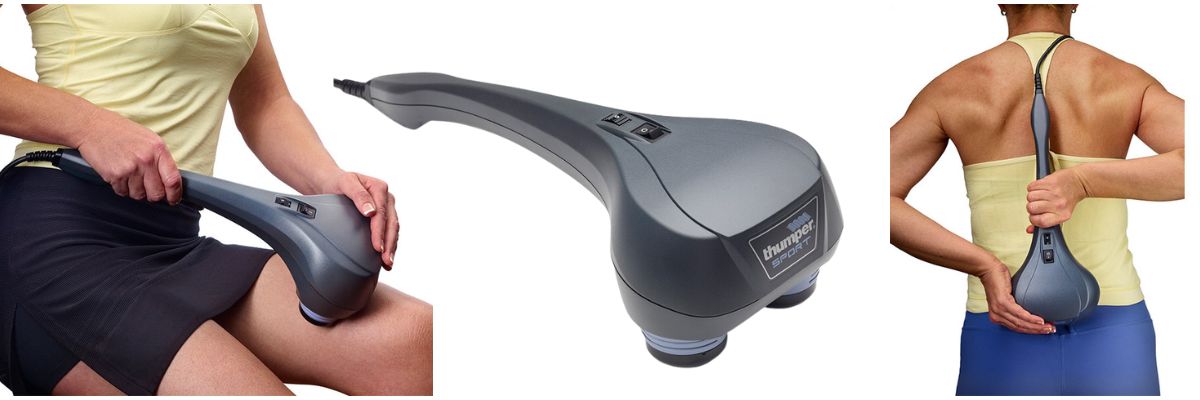
Easing tightness and tension in bigger muscle groups
Great for working into larger areas like the hamstrings, quads, glutes, either side of the spine and the calf muscles
⭐️⭐️⭐️ (3 stars)
We have mixed feelings about this Thumper. It's easy to use on the back half of your body, due to the long handle, but we wanted more pressure and couldn’t quite achieve it. On the front half of the body, it was a different story. We think the same or better results could potentially be achieved through foam rolling, although the Thumper is a more pleasant experience.
There are other Thumper Massagers available, so please check them out for yourself
Headaches are a common ailment, which will have been experienced by most people at some point. In fact they’re so common that we often don’t give them the proper attention they deserve - we may ‘pop a pill’ or ‘sleep it off’. However, there are different types of headaches and therefore different reasons as to why they occur. It’s worth looking at the factors which may trigger a headache in order to treat it correctly. We give you a summary overview here in this article.
Very simply, a headache is a pain experienced in the head, which can manifest as a dull ache, a sharp pain or pulsating/throbbing. Symptoms tend to be:
● Pain or discomfort in the head and/or face
● Tenderness of the scalp
● Pressure in the head and/or behind the eyes
● Hypersensitivity to sound, light and temperature
● Dehydration
● Erratic eating patterns
● Food allergies or intolerances
● Stress
● Eye and/or eyesight issues
● Muscle tension and/or tightness
● Injury to the back, neck, shoulders or head
● Poor/incorrect posture
● Lack of sleep
● Illness such as flu
● Menstruation
● Hormone imbalances
● Overconsumption of alcohol or caffeine
These lists are illustrative and not exhaustive.
Tension - the most common type of headache, which feels like a tightening or a pressure around the head
Hormone - changes in hormone levels can trigger headaches and can be brought on by menstruation, contraception, pregnancy, menopause or HRT
Cluster - an intense head pain, usually experienced on one side of the head and/or face and eye. Not overly common. Tend to be experienced from middle age onwards. Come on suddenly and can last for several weeks. Can cause changes to the eye, such as redness, watering or swelling, as well as extreme agitation in a person. Cluster headaches have been linked to smoking and genetic predisposition. Seek medical advice as further investigation and stronger prescription medications will be required.
Migraine - moderate to intense head pain, often experienced alongside nausea and/or sickness, brain fog, increased sensitivity to light, sound and/or temperature. Can occur from teens onwards. Can last for hours to days. There are three different types of migraine, which include the previously mentioned symptoms and:
Seek medical advice as further investigation and stronger prescription medications will be required.
Drink Water - try to drink at least 2 litres per day. Ensure you drink enough water to replace any lost through exercise and perspiration, or diuretic drinks, like tea and coffee
Medication - over-the-counter (OTC) painkillers such as paracetamol, ibuprofen and aspirin. Cluster headaches and migraines will require medical guidance for medication.
Ergonomics - ensure you keep your body in neutral alignment wherever possible. Consider how your seating, standing and lying positions affect your posture - do you have the correct support for your body, particularly when sitting and sleeping? Do you work from home - does your workplace set need to be assessed?
Rest and De-stress - take some time to rest and recuperate, allowing the pain to subside
Light Exercise - stretches/yoga, walking or a massage to help alleviate any muscle tension or tightness
Avoid - any food or drink that triggers allergies or intolerances
Test - get regular eye tests
Alternative Therapies - both acupuncture and reflexology have been known to help alleviate pain and headache symptoms
Always seek medical advice prior to treatment and/or consult a pharmacist.
All of the below equipment is available from our Partner Providers, Physique at 10% discount.
Use a combination of the below to help relieve your symptoms as appropriate:

This is a question we get asked frequently at Body Mechanics, so we thought it’d be useful to give you a summary overview.
Physiotherapists, Chiropractors and Osteopaths are all physical therapists who look to promote optimal physical health - integrity, function and movement - of the body’s soft tissues, joints and systems.
They can be used to:
A wide range of health conditions can be treated through these therapies such as back pain, sports injuries, stroke, MS, heart attack, cystic fibrosis and many more. Although their aim is ultimately the same, their approaches and priorities differ.
- takes a holistic approach to treating the body, as well as focusing on a particular issue area when appropriate. They will offer tailored education, advice, and rehab exercise schedules, as well as using manual therapy, where the Physio will use their hands to encourage better function and movement of the body.
Broadly speaking Physio’s will put soft tissue first - muscles, ligaments, fascia, and tendons - and joints second. When it comes to treating a system within the body, a more holistic approach will be adopted.
Other techniques such as dry needling, acupuncture, ultrasound, and transcutaneous electrical nerve stimulation (TENS) can be used to work into the joints and soft tissues.
Registered Physiotherapists can be found at The Chartered Society of Physiotherapy
- is considered by some, to be a blending of both physiotherapy and chiropractic, in that Osteopaths adopt a holistic, combined approach, looking at both soft tissues and joints throughout the body and not in isolation.
Osteo’s will work into both the soft tissues by way of stretching and massaging, to loosen muscles, ligaments, fascia, and tendons. Joints will be articulated and taken through their full range of motion to then enable any joint manipulations or adjustments, similar to Chiropractic, using quick controlled movements and/or pressure to realign the bones/joints.
Osteo’s will frequently offer guidance on rehab exercises and self-care treatments at home. They may often use other techniques such as dry needling, transcutaneous electrical nerve stimulation (TENS) low level massage.
Osteopathy can sometimes feel unusual and intense, but it should never feel painful.
Registered Osteopaths can be found at The General Osteopathic Council
- places its focus on the spine. Chiropractors work on the premise that the spine is the body's main structural support, neural highway, and movement enabler, so correct alignment of the vertebrae will subsequently keep the rest of the body healthy as a result.
Generally, Chiro’s will put joints before soft tissues, however, they may work into the soft tissues by way of stretching, to help ease any tension and tightness. These stretches allow Chiro’s to ‘free up’ a particular vertebrae or joint. They use spinal manipulation or adjustments to help realign the spine, which may involve quick, controlled movements and/or pressure. This can at times feel odd, but at no point should it be painful.
Registered Chiropractors can be found at The General Chiropractic Council
We personally prefer Osteopathy as a manual therapy as we consider it to be the more comprehensive of the three. Where appropriate we advise our clients to maintain their physical health through regular exercise, osteopathy and sports massage, as this ensures general fitness, structural/skeletal alignment and healthy soft tissues. We use Osteopathy on a monthly to quarterly basis for maintenance and get massage at least once a month for wear and tear.
Sprains and strains are injuries which occur to our body’s soft tissues, such as our muscles, tendons, and the ligaments - our connective tissues. However, there is a difference between the two.
Sprains refer to an overstretching or tearing of ligaments which subsequently stress a joint - tissues that connect two bones together. Common examples are a sprained ankle or wrist
Strains refer to an overstretching or tearing of muscles or tendons - tissues that connect a muscle to a bone. Common examples are the back or hamstring muscles
Strains
Acute (immediate) injuries - tend to be caused by an overloading of the muscle or tendon during activity such as lifting, where the load is too heavy and/or lifted using incorrect technique
Chronic (occur over time) injuries - tend to result from repetitive movements where the muscle or tendon is put under strain frequently.
Sprains
Sprains tend to occur in highly mobile areas of the body, such as the knee, ankle, wrist or thumb and happen due to ‘landing’ awkwardly on uneven surfaces when pivoting, jumping, overextending or bracing yourself
Consult a Physical Therapist to receive bespoke rehab exercises.
Begin to re-use the injured area after 48 hours if possible. If you can’t and/or unable to , seek medical help
Cold Therapy - a cold gel or cold pack can be used on the localised area to reduce any present inflammation
Heat Therapy - a heat lotion, gel or pack can be used on tight muscles around the injured area, not on, the injured area itself
Painkillers - over the counter medicines like ibuprofen (anti-inflammatory) and paracetamol (compound analgesic/painkiller) can help reduce pain and increase comfort in the short term and as a temporary measure.
Physical Therapy - Physiotherapists and Sports Massage Therapists will all be able to help treat and sprains or strains, gradually increasing mobility and strength
All of the below equipment is available from our Partner Providers, Physique at 10% discount using the code: BODYMECHANICS

Osteopathy is a non-invasive manual therapy, which helps to maintain overall health and wellbeing by focusing on skeletal and soft tissue integrity. By maintaining good skeletal alignment throughout, Osteopathy optimises the function and repair of muscles, nerves, connective tissues and therefore systems within the body.
Osteopathy can help with a number of issues. It can help to:
Numerous conditions can be diagnosed and treated by viewing the body as a whole; identifying and isolating the cause from the symptoms.
Prior to treatment, your Osteopath will discuss your symptoms, medical history, lifestyle, as well as assessing your current flexibility and movement, and of course, your health and wellbeing objectives.
Treatment work will involve a combination of:
to correct and restore your body’s skeletal health, function and capability.
Aftercare advice is given to maximise treatment results. You will receive advice on stretches, exercises and low-level self-care, such as hot/cold packs, joint supports, foam rolling and more.
WANT TO BOOK A OSTEOPATHY APPOINTMENT
(Both Corporate and Private Enquiries)
Massage helps to relieve and manage pain and discomfort, to increase range of movement, to improve posture and to promote overall health and wellbeing.
By keeping muscle tone and condition at its best, it allows nerves, connective tissues and joints to stay healthy, functional and with the ability to repair and heal.
A non-invasive, hands-on treatment working into the body’s soft tissues, more specifically the muscles and connective tissues.
Massage does a number of things. It helps to:
Massage can help relieve numerous conditions, both sudden, acute injuries and on-going, chronic conditions, can be treated, by identifying and isolating the cause from the symptoms.
Prior to treatment, your Massage Therapist will discuss your symptoms, medical history, lifestyle, as well as assessing your current flexibility and movement, and of course, your health and wellbeing objectives.
An appropriate type of massage will be used to treat your symptoms and possibly alongside some stretching:
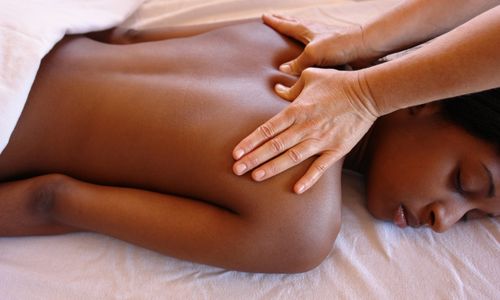
Various massage strokes and techniques will be used, with light to firm pressure as appropriate, to work into the muscles, joints and soft tissues, helping to alleviate any discomfort.
Towels are provided to maintain your modesty at all times
Aftercare advice is given to maximise treatment results. You will receive advice on stretches, exercises and low-level self-care, such as hot/cold packs, joint supports, foam rolling and more.
Plantar Fasciitis is inflammation of the fascia, or connective tissue, running along the sole of your foot, from your heel to your toes. The plantar fascia is a thick connective band which acts as both a support and a shock absorber in the foot. Plantar fasciitis is generally caused by repetitive stress and tension being placed upon the foot, through general wear and tear, straining/overstretching or injuring the fascia and/or foot. You are more susceptible to developing plantar fasciitis if you:
Common Symptoms:
Avoid the following activities which will likely exacerbate your symptoms:
Use a combination of the below to help relieve your symptoms:
Cold Therapy - a cold gel or cold pack can be used on the localised area to reduce any present inflammation
Heat Therapy - a heat lotion, gel or pack can be used on tight calf muscles to help to relax muscles
Appropriate Footwear - wear footwear which offers a suitable amount of cushioning and support, particularly around the heels and the arches of the feet. Please consult a podiatrist prior to selecting orthotics and foot supports.
Painkillers - over the counter medicines like ibuprofen (anti-inflammatory) and paracetamol (compound analgesic/painkiller) can help reduce pain and increase comfort in the short term and as a temporary measure. Only take ibuprofen 48 hours after injury/symptoms.
Physical Therapy - Podiatrists, Physiotherapists and Sports Massage Therapists will all be able to help treat plantar fasciitis
There are 3 key exercises and stretches which can help improve your recovery results, by gradually increasing the flexibility and reducing the tightness of the plantar fascia and calf muscles. They can be carried out in the order of your choice:
1. Foot Stretches -
2. Leg Stretches -
3. Massage -
Sometimes discomfort and pain are caused by muscle weakness and changes in posture. For example, we can experience ‘round shoulders’ from the pectoral muscles in our chest getting tight and short and from our rhomboids between our shoulder blades, getting overextended and weak. Health Professionals such as Sports Massage Therapists, Physiotherapists and Osteopaths will be able to provide you with a bespoke assessment of any muscle imbalances, along with any strengthening exercises.
If the above corrective action fails to work, you may need to visit your GP.
All of the below equipment is available from our Partner Providers, Physique at 10% discount using the code: BODYMECHANICS

